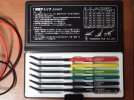- Joined
- Mar 22, 2021
- Messages
- 47
I was thinking that I shouldn't even say anything as I'm new to posting and I didn't want to upset anyone on here, being that there are a lot of collectors, but this morning I thought differently. I'm not trying to hurt anyone's feelings, but there does seem to be a problem with manufacturers posting the hardness of a steel they use on a knife and the actual hardness that a given knife can be measured at. First, I was a knife sharpener for many years and was able to handle many different types of steel and was always amazed by the rare example of a blade that was perfectly hardened. Some steels were beyond all reasoning when it came to this somewhat non-scientific approach, but just imagine that I sharpened well over 100,000 knives and I always paid attention to what I was doing.
Secondly I personally made about 60 knives myself, all in ATS-34, and every one of them was Rockwell tested by myself to make sure that they were at the stated hardness which was 61 on the C scale. Also I want to say that I'm not a scientist and my overall methods were somewhat less that scientific, but I think that applies to most of us.
I have a few knives in ZDP-189, and they are all of San Mai construction, that is there's a softer steel on either side of the cutting steel, so I don't know how a company would measure the actual hardness of the edge. But I can tell you that the person sharpening can tell you right away. Many years ago there was a particular manufactured knife that was very much in demand and I discovered that there were some that were not hardened at all! They were all about 45-50 Rockwell and I had to argue with some people to not ship those blades. When we would get a shipment of blades back from the heat treater we would pull a few off and measure them, and there was quite a variety when it came down to what we would measure. But I can tell you all that very few blades were ever cast aside because they weren't up to par hardness wise. That is manufacturing. That is the real world.
So now there's some discussion about the merits of M390 vs 20CV and what it all means in term of edge retention. I can say for certain that it means everything. An ATS-34 blade that is actually 61 Rockwell will out cut a 20CV blade that is only 58. And I own some blades that are not as hard as they should be. When I watch a video of someone performing a cutting test, that is with two knives if the same steel, first I admire them for trying, but are they really comparing an apple to another apple?
I'm not an expert, and I welcome your responses. Please let me know what you think. I have carried a couple of different blades in M390, and a couple in 204P and I have some opinions on which steel is better.
Thanks for reading.
dt
Secondly I personally made about 60 knives myself, all in ATS-34, and every one of them was Rockwell tested by myself to make sure that they were at the stated hardness which was 61 on the C scale. Also I want to say that I'm not a scientist and my overall methods were somewhat less that scientific, but I think that applies to most of us.
I have a few knives in ZDP-189, and they are all of San Mai construction, that is there's a softer steel on either side of the cutting steel, so I don't know how a company would measure the actual hardness of the edge. But I can tell you that the person sharpening can tell you right away. Many years ago there was a particular manufactured knife that was very much in demand and I discovered that there were some that were not hardened at all! They were all about 45-50 Rockwell and I had to argue with some people to not ship those blades. When we would get a shipment of blades back from the heat treater we would pull a few off and measure them, and there was quite a variety when it came down to what we would measure. But I can tell you all that very few blades were ever cast aside because they weren't up to par hardness wise. That is manufacturing. That is the real world.
So now there's some discussion about the merits of M390 vs 20CV and what it all means in term of edge retention. I can say for certain that it means everything. An ATS-34 blade that is actually 61 Rockwell will out cut a 20CV blade that is only 58. And I own some blades that are not as hard as they should be. When I watch a video of someone performing a cutting test, that is with two knives if the same steel, first I admire them for trying, but are they really comparing an apple to another apple?
I'm not an expert, and I welcome your responses. Please let me know what you think. I have carried a couple of different blades in M390, and a couple in 204P and I have some opinions on which steel is better.
Thanks for reading.
dt

